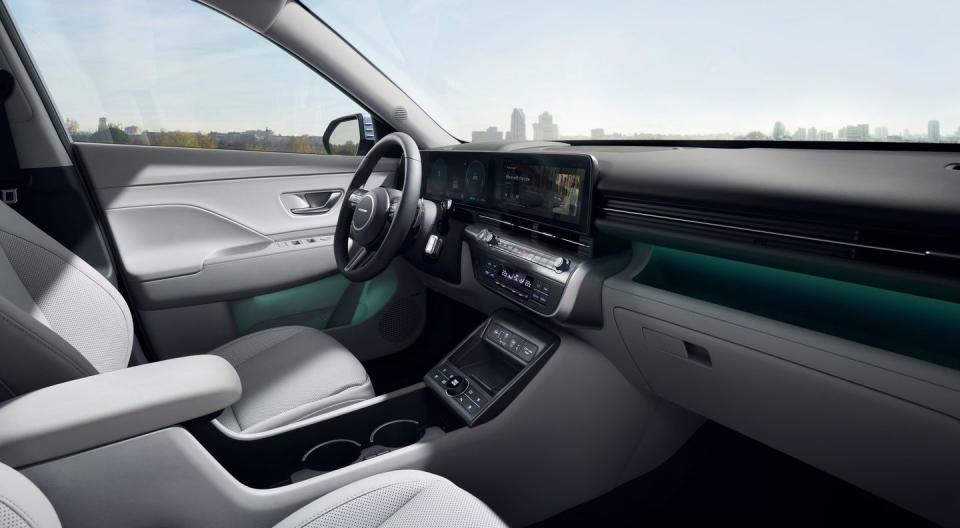2024 Hyundai Kona Gets Premium Looks, EV and ICE Powertrains

A first look of the 2024 Hyundai Kona reveals a car embracing distinctly EV-like styling, even with its gas-engine version.
It sports a more aerodynamic nose—and impressive 0.27 drag coefficient—including active air flaps that are usually found in pricier segments.
More specifics will be released at its New York auto show debut next month.
The 2024 Hyundai Kona has just debuted, and we’ve had the opportunity to get up close with the new crossover. From the first glance, the new Kona looks more premium, and that is very much by intention. Hyundai’s head of design, SangYup Lee, tells us the design directive was to go “upscale.” Uniquely, though not on a dedicated electric vehicle platform like the Hyundai Ioniq 5 and Ioniq 6, Hyundai says the Kona was designed with the EV in mind first, and some of the EV-centric features carry over to the gas and hybrid models.
We’ll likely see this more as the industry increasingly shifts to electric cars. In the case of Kona, the front-end goes for an EV-heavy aesthetic; featuring a more aerodynamic nose—and boasting an impressive 0.27 drag coefficient—active air flaps that are usually found in pricier segments, a frunk on the electric version for additional storage, and a flat floor on the interior. The strongest design element may be the EV’s Pixelated Seamless Horizon Lamp, the wrap-around one-piece LED daytime running light which Hyundai says is the biggest in the industry, aside from the Hyundai Grandeur sedan, sold in South Korea, and other limited markets.

Lee says given the complexity of producing such a light, the cost, and with the overall effect on the first impression, it is his favorite design element on the new model. Crucially, it shows an attention to detail that you can also see on the signature profile line that cuts diagonally across the side, and ends in a fine point on the front doors. Sculpted wheel arches add a bit of muscle, but it’s also a clever visual effect. The arches don’t actually protrude much over the wheels, but careful sculpting of the sheet metal and profile give this impression. “We really went 3D there to create that effect,” Lee says. The taillights look as though they were pulled from a pricier segment, as well.
Given a tough competitive set that includes the Ford Bronco Sport, Volkswagen Taos, Honda HR-V, and Toyota C-HR, Hyundai will need a strong player to compete. Helping that cause, is a new, roomier interior. The 2024 Kona gets stretched 5.9 inches, is an inch wider, and the wheelbase grows by 2.4 inches. While passengers will get a little more space, the biggest beneficiary of that extra half-foot of length will be the cargo area in the rear, something Kona owners of the current generation asked for. The new dimensions propel the Kona to roomier side of the segment.
Stepping inside the cabin you can see Kona has swapped a sporty, playful cabin for one that is materials-quality away from being entry-level luxury. There are dual, side-by-side 12.3-inch screens available, pops of ambient lighting on the doors and above the glove box, the Hyundai logo gets deleted from the wheel like on its Ioniq 6 cousin. A column shifter further frees up space. It all adds up to a more modern, ergonomic, and focused cabin.

Hyundai will keep its strategy of selling the electric and gas models for the United States, while other markets will have the hybrid option. As far as powertrains, and range on the EVs, we’re told exact specifications for the US market will be announced when the Kona makes its debut stateside at the New York International Auto Show in a few weeks. But we know now Kona’s existing powertrains on the current generation are expected to carry over, including the 1.6-liter four-cylinder, and 2.0-liter turbo-four. Hyundai hinted that despite growing in size, Kona EV should provide about the same range from its 65.4-kWh battery, and 160 kW electric motor, that powers the front wheels. The Kona doesn’t have the ultra-fast charging times of its Ioniq cousins based on the dedicated-electric EGMP platform, but it can charge from 10 percent to 80 percent in 41 minutes.
A Kona N performance model that should still make it stateside. At our intimate preview in Berlin, Hyundai had a static Kona N on display, boasting black mirrors, a split roof spoiler, a lower stance, unique 19-inch alloy wheels, twin exhausts, and a silver side skirt. The N model also features red stitching accents on the dash, seats, and wheel, metal pedals, and an N-specific shifter. At least 11 colors will be available globally on the each variant, with a couple unique colors for the EV, and gas versions.
New for Kona will be over the air updates (OTA), and a bevy of advanced driver assistance and safety systems, some of which are not available in the competition. While we’ll get more US-specifics soon, including pricing, we’re confident the new Kona’s larger dimensions, upmarket looks, and variety of powertrain options will provide an alluring alternative in the field.

Think the 2024 Hyundai Kona has what it takes to compete in a crowded segment? Share your thoughts in the comments below.

 Yahoo Autos
Yahoo Autos 